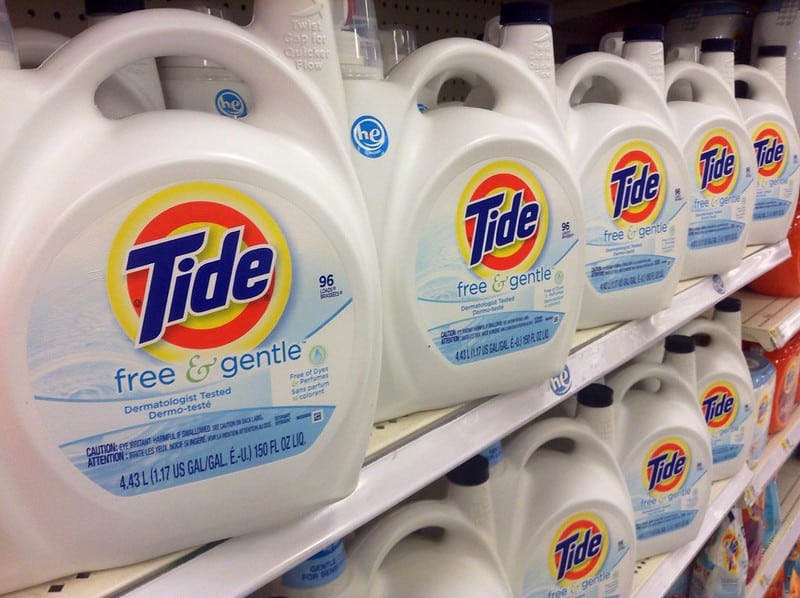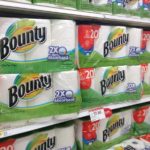Procter & Gamble is putting a happy face on inflation, saying it can charge more money, make more money, and consumers won’t even flinch.
But there are other indications that cost-conscious shoppers have had enough. So which is it – are shoppers really shrugging off higher prices, or are they swearing off products that are becoming too pricey?
P&G looked on the bright side last week in a call with investors. As costs for raw materials, transportation and labor continue to rise, the company has been passing along those costs in the form of price increases at the shelf. And it expects more price hikes in the year ahead.
But not to worry, company executives said. Revenue rose 6% this past quarter from the same time last year, because shoppers are happily buying higher-priced Tide, Bounty, Crest and other P&G products.
“So far, we haven’t seen noticeable changes in consumer behavior,” Chief Financial Officer Andre Schulten said. “The consumer is healthy generally,” and shoppers “continue to prefer P&G brands and the superior performance they provide even as inflation is impacting household budgets.”
Part of the reason may be that P&G makes mostly household and personal care necessities. You can’t stop buying soap or toothpaste just because it gets pricey, and many loyal shoppers are reluctant to part with their favorite brands even as the prices creep upward.
Conagra is similarly optimistic that higher prices won’t mean fewer customers. But the company, which owns brands like Birds Eye and Duncan Hines, has a theory about why shoppers aren’t balking at higher food prices.
“Consumers have been able to save money on food because of the shift to food at home,” Conagra CEO Sean Connolly said earlier this month. “Previously, a consumer’s comparison of choices was between close proximity items inside the grocery store,” as they studied price tags while shopping. But now that people who were accustomed to eating out have been working from home and eating out less often, “the biggest comparison taking place from a value standpoint is between away-from-home choices and at-home choices,” Connolly said. In other words, even higher-priced groceries are still less expensive than restaurant food, so those who had been infrequent grocery shoppers don’t even notice or particularly mind that prices have gone up.
Other retail leaders are more circumspect. “We have a strong consumer, and we haven’t seen a dramatic change in their pattern of consumption,” Albertsons CEO Vivek Sankaran said a couple of weeks ago. “What we don’t know is if inflation continues to go up, does that behavior change as we go through the calendar 2022? We don’t know that.”
A recent Motley Fool analysis of Kraft Heinz’s financial performance found that “as the company has been raising prices, it has been able to generate more revenue.” But higher prices have been offset by lower volumes. “In other words,” the analysis concluded, “Kraft Heinz raised prices, and it led to a drop in demand. That’s not a good sign if inflation remains high and the company has to keep increasing what it charges.”
And the numbers don’t lie. As manufacturers consider just how high they can go before consumers balk at their price hikes, the latest government figures show that retail sales dropped 1.9% last month, as higher prices contributed to reduced spending. And even P&G’s CEO is mindful of the warning signs. “So far, it’s going very well,” Jon Moeller said of his company’s efforts to raise prices without harming demand. But, he added, “there is no doubt in my mind that there will be bumps in this road.”
His colleague’s proposed solution is that those who can afford to do so, can pay higher prices paired with innovation for P&G’s premium products. Others can trade down to less expensive P&G products. “When you think about diapers, you can get a Luvs diaper for 15 cents a diaper, Swaddlers at 30 cents, or a Pure diaper at 38 cents,” Schulten, the CFO, explained. “We have offerings for the consumer at different price points… so that means the consumer has a choice within our portfolio.”
As Kraft Heinz is finding out, and others may as well, consumers also have a choice outside any one manufacturer’s portfolio. They may switch to cheaper brands, store brands, or in some cases, just do without. So keep an eye on those shelf tags – your willingness to pay more, or not, could determine whether manufacturers telling a rosy story about the minimal impact of higher prices on consumers, may soon have a different story to tell.
Image source: JeepersMedia
















